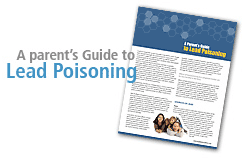|
Lead: Threats and Body Screening:
You may be aware of various kinds of poisoning caused by many things. However, lead poisoning is the most common as it is always around our daily use items and it can prove very fatal for us but most of the time, we remain oblivious to it. Lead is everywhere in our environment and it can enter our bodies through various sources like drinking water, paint, pottery items, contamination of soil or simply through airborne particulates.
Lead poisoning affects both adults and children, however children are mostly affected more frequently and this can lead to anemia, colic pains and even the upsetting of metabolism, especially of Vitamin D. It’s shocking that almost 1 in 22 American children have high lead content in their blood.
How to protect your family from lead poisoning:
Usually, lead levels are difficult to detect as there are no visible symptoms until sufficient damage is done. Thus, you can go for a Lead Confirm Professional oral screening kit which is the sure-shot way to find out if your family has been exposed to metal pollutants like lead and the extent of the exposure. Once you have the concrete information, you can consult a doctor and take the necessary medication, if necessary.
What is the test about?
The Lead Confirm Professional™ saliva lead screening kit is a medical testing device which will help you understand whether your family and you have been exposed to dangerous levels of lead pollution and contamination.
Characteristics and Advantages of the test:
- It is 99.9% accurate in its diagnosis. The kit has been approved by the FDA and gives as reliable results as those of our blood tests. The kit is prepared in a CLIA Accredited Laboratory that uses state-of-the-art technology like the Liquid Chromatography (HPLC) with Mass Spectrometry X2 (LC/MS/MS) technology which accurately detects the level of lead present in our body.
- The lead report sent to you after the test will provide concrete information about the amount of lead in your or your children’s bodies which will help you take medical advice, if necessary.
- The Lead Confirm Professional kit is based on a saliva test, thus making it painless and easy for children.
- It is very easy to use and you simply need to allow the sponge applicator in the kit, to be saturated in saliva. Post that it is posted in testing device provided and dispatched to laboratory with a pre-paid mailer. The results will be sent to you soon and will be accurate.
Dangerous facts of Lead:
- Lead exposure harms infants and young children, sometimes even in the mother’s womb.
- Healthy children are also likely to have high amounts of lead in their bodies.
- Lead can enter your body through mundane activities like breathing or swallowing lead dust or babies eating soil or paint chips which have lead.
- It is astounding that over 1million workers are exposed to lead poisoning everyday at their workplace.
- Lead poison is the foremost killer of babies in the U.S., especially those under 6. The effects are speech delay, learning disabilities, stunted growth, anemia, hearing impairment, lack of attention-giving and concentration abilities, sometimes also leading to the more serious neurological and renal damage or even causing mental retardation in children.
A few common sources of Lead:
- Paint: Lead was earlier used in paint so that the paint would be more durable and as a result, these paints were used both inside and outside a home. The federal government has banned lead paint since 1978. However, if your house is older than that, it might have lead-based paint or even the old toys and furniture might have it. It becomes dangerous as children usually eat paint chips of the walls or chew the surfaces of toys, cribs, chairs, windows or doors.
- Soil: Lead was used in gasoline before 1978. These lead particles were emitted from car exhaust systems and it mixed with the soil on the roads. Thus, homes near busy traffic streets will have highly contaminated lead in the soil around. Lead also is released into the air and the soil by metal smelting, battery manufacturing and many other factories. Flakes of lead-based paint on chipped home walls may also cause high lead content in the soil around.
- Drinking Water: All homes built before 1930 will have lead plumbing which lets the lead particles flow in with the water. Plumbing parts like faucets, fittings or pipes will definitely contain lead. If you use an old water well pump, then its brass and bronze parts will also contain lead. Nowadays, copper pipes are used but lead is used to solder the pipes. Lead generally gets into soft or acidic water, thus contaminating drinking water. The government has passed laws to ban the use of lead in faucets and pipes, in 1986 and 1988.
- Lead Dust: This is the most common form of exposure as lead dust is to be found inside our homes, where it comes from chipping or peeling paint from doors and windows and is dangerous as it is not visible to the naked eye and anyone can be contaminated by breathing in this dust. Lead dust easily spreads in the house as young children and even adults at times stand against the walls or lean on the doors and windows, which causes the paint to peel off or sections of the wall to chip off, which gives out lead dust.
- Professions and Hobbies: Those who are exposed to lead at their workplaces often carry it home on their clothes, shoes, skin and hair. These professions include home construction and repairing jobs, painting and plumbing jobs, welding, cutting, refinishing furniture, repairing car radiators, electronic jobs and battery manufacturing. Also, rubber and plastics industries, brass and bronze foundries, lead compound manufacturing places, municipal waste incineration units are professions which involve high exposure to lead. Hobbies like pottery, stained glass painting, fishing or refinishing of furniture include lead exposure. Thus, it is recommended that all such people take a shower and change clothes before coming home. Send your clothes separately to the laundry. Otherwise, the lead dust will easily spread in your house and will first of all contaminate the breathing of infants and babies.
- Imported goodies: Imported toys and even local toys are made of lead- containing materials and even painted with lead-based paints so they can be very harmful for babies and children as they tend to put toys into their mouths and lick the paint;
- Food cans: Most food cans that are imported to the U.S contain high lead content in their covers and the lead solder on the seams of the cans. Most of the times, such cans are not inspected and especially their covers are not checked. People just open the cans and use the food inside. However, the truth is that when the cans are shipped across the seas, then in the heat and the humidity, the lead from the can covers and the seams slowly mixes with the food or liquid contents of the can, thus causing high threat of lead contamination. This happens mostly with food or liquids with acidic content which absorbs lead faster and even reacts fast to it, the consumption of which might lead to severe lead poisoning.
- Folk Medicines: Some folk medicines are imported from Mexico or south Asia like Greta, Azarcon, Bala, Golf, Ghasard and Kandu which are very considered very useful for treating upset stomachs. However, they have been tested and it has been found that such medicines have a high lead content and may be harmful if continued over a long period of time.
- Imported Cosmetics: Many of us are lured in by our attraction to exotic cosmetics like Kohl and Surma. These cosmetics are used for darkening and shading the eyes and are imported from the Middle East, India or Mexico or other south-Asian countries. However, these imported cosmetics are known to contain lead and can be dangerous.
- Imported Goodies: Children love nothing better than chocolates, especially imported ones. The U.S. imports many candies and exotic chocolates but how far are they lead-free? It has been found out that most imported candies have great amounts of lead in it, especially candies from Mexico which contain chili or tamarind. Sometimes even candy wrappers and gift items like pottery containers contain high amounts of lead.
- Miscellaneous items: things like firearms, candle wicks, leaded glass, fishing sinkers, car bodies and car body fillers of custom cars, imported crayons, organ pipes, electrodes used in electrolysis, lead solders, high voltage power cables used for sheathing, lead materials used for roofing purposes, some kinds of hair dyes, make up products, billiard chalk and vinyl lunch boxes also contain lead in very heavy amounts which can lead to lead poisoning.
Thus, it is mandatory that you go for a Lead Confirm Professional kit to test the level of lead in your and your family’s blood and rest assured.
|






|

